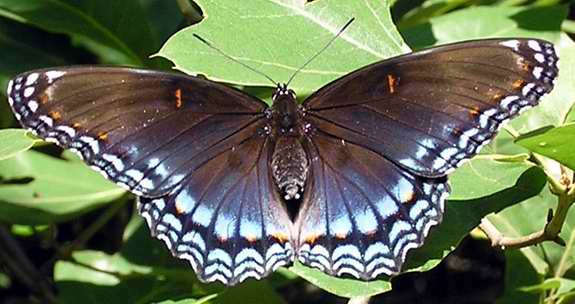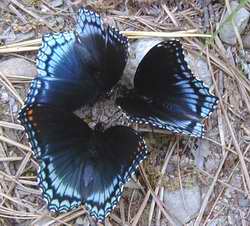|
Common Name: Red-Spotted Purple (for the red spots on the underside of the wing and the purple upper wings), Red-Spotted Admiral, White Admiral (with white bars) Scientific Name: Basilarchia astyanax or Limenitis arthemis
Potpourri: The Red-Spotted Purple, like many butterflies, has an elaborate defensive scheme against predators. It mimics the Pipevine Swallowtail, whose larvae feed on plants of the birthwort family which contain the chemical aristolochic acid that is unpalatable to predators. Due to the mimicry, predators avoid both butterflies.
Red-Spotted
Purple males engage in "puddling," a
The Red-Spotted Purple (B. astyanax) and the White Admiral (L. arthemis) are closely related subspecies that hybridize on the border between their ranges. The former is found in the south and the latter in the north with a mixture in Pennsylvania and New York. A combined name of Red-Spotted Admiral has been adopted by some groups. |

 congregation
of many butterflies on a patch of mineral rich muddy ground, dung, carrion or
urine. Using their long proboscises, they extract salts and nitrogen which
they form into a spermatophore, a sac containing sperm and nutrients that they
pass to the female during mating.
congregation
of many butterflies on a patch of mineral rich muddy ground, dung, carrion or
urine. Using their long proboscises, they extract salts and nitrogen which
they form into a spermatophore, a sac containing sperm and nutrients that they
pass to the female during mating.